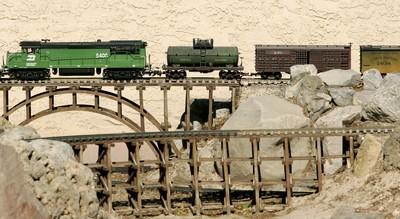CREATING A WORLD OF THEIR OWN

Normally, a railroad running through your backyard isn’t a good thing.
But, for Chuck and Pat McManis, a backyard railroad isn’t just good. It’s seriously cool.
The McManises are among dozens of Southern Nevadans who are enthusiasts of garden railways, outfitting their yards with pint-sized, but realistic-looking, engines, rolling stock, trees, mountains and, yes, people.
This week, they and other garden railway hobbyists from around the world will gather at the Riviera for the 23rd National Garden Railway Convention, which is taking place for the first time in Las Vegas.
Here, fantasy railroad magnates will learn about their favorite pastime, tour local layouts and, probably, return home with a few ideas to incorporate into their own miniature lines back home.
Garden railroading was developed in Great Britain — their “garden” is roughly synonymous with our own “yard” — and makes use of trains that are larger than the Lionel or HO trains many Americans remember from their youths. They are 1/24th scale and run on tracks with a rail width of 45 millimeters, versus the classic Lionel’s 32 millimeters.
Odds are many Southern Nevadans already are familiar with garden railways: Every Christmas season, the Las Vegas Garden Railway Society assembles a layout as part of Embarq’s, formerly Sprint’s, holiday display.
Pat and Chuck McManis have had a layout in the backyard of their Las Vegas home for about 17 years. Today, it includes about 500 feet of track and spans the width of their backyard.
Chuck McManis remembers having a Lionel train when he was a kid. But the couple’s love of garden railways was ignited in 1968 while Chuck was stationed in Brussels, Belgium, with the Air Force. It was there that they saw European-made trains pricey enough that, Chuck says, “with four kids and Air Force pay, there was no way we were gonna do that.”
But, he continues, “when we got to be empty-nesters, that gave us a little extra money, so we started buying trains.”
John Craft has been a garden railway hobbyist since 1992. He caught the bug after seeing another local enthusiast’s layout.
Craft had a Lionel engine as a kid, but no track to run it on. However, he has made up for lost time with an elaborate layout in his backyard that includes 800 feet of track, 25 turnouts, seven sidings and about 40 miniature buildings equipped with lights for nighttime viewing.
“I’m just a grown-up kid,” jokes Craft, who’ll be 74 in August.
As with many hobbies, garden railroading can be as simple or as complicated — and as inexpensive or as budget-breaking — as one desires. Chuck McManis estimates that a basic starter set –a 36-inch-diameter circular track, a locomotive and a few cars — will begin at about $100.
Then, he says, “from there you just start adding zeroes.”
And that doesn’t include the landscape features — the model trees, landscapes, buildings and people — that, taken together, give a train a realistic environment to operate in.
As the name implies, garden railways are intended to be run outside, year-round.
“We don’t have snow and bad weather, which makes it nice,” Craft says, even though the summer sun here can weather landscape features and make tracks expand and contract. In addition, the valley’s blowing dust demands regular track cleaning.
That’s not necessarily a bad thing, though. Pat McManis says a sun-beaten, decades-old wooden building on their layout soon will receive an appropriate touch: a “Stay Out — Condemned” sign.